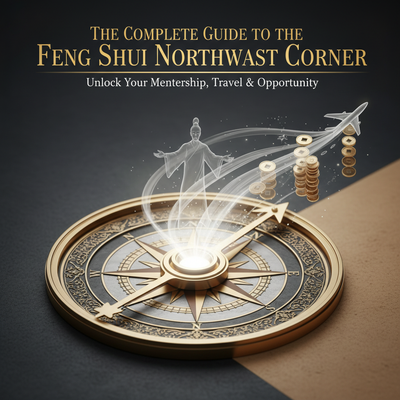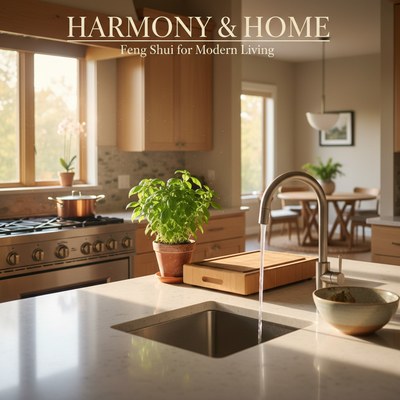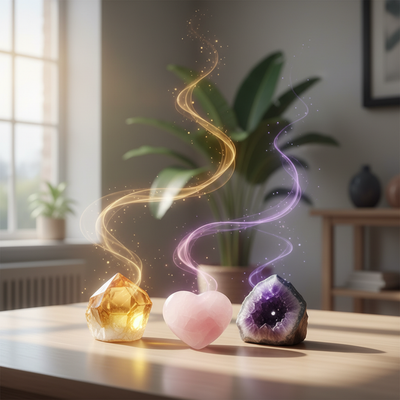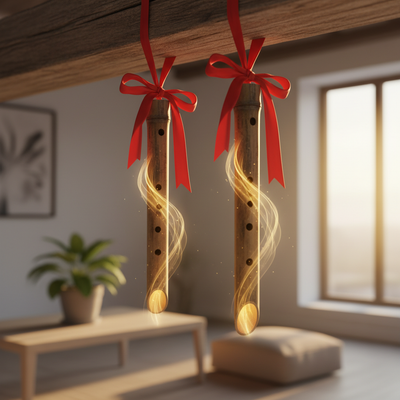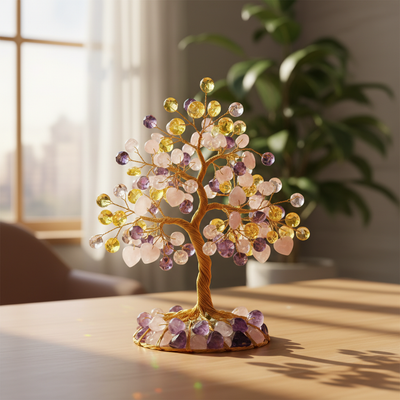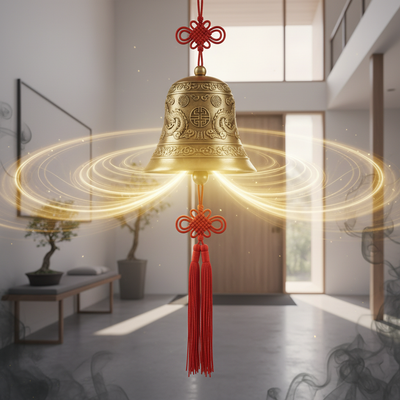Your bedroom is more than just a place to sleep. It is a safe space for rest, renewal, and connection. In Feng Shui, the ancient practice of arranging spaces, every item in this special room has energy, and nothing is more important than the art you hang directly above your bed. This single choice can deeply affect your mind while you sleep, changing your sleep quality, emotions, and even your relationships.
So, what is the best feng shui bedroom art above bed? Simply put, the best art is something that feels supportive, calming, and personally meaningful. It often shows stable landscapes, pairs of objects, or gentle abstract forms. It should make you feel secure and loved, not stressed or unstable. This guide will walk you through the main principles, the specific do's and don'ts, expert insights, and a practical installation guide to help you choose with confidence.
The "Why": Energy Principles

Understanding the basic principles behind these guidelines helps you make natural choices that work with your personal energy. The art above your bed is not just decoration; it's a constant energy message to your mind, especially during the vulnerable state of sleep.
Command Position and Backing
In Feng Shui, the ideal bed placement is in the "command position," where you can see the door without being directly in line with it. The wall your headboard rests against acts as your "backing," representing a strong, stable mountain offering support and protection in your life. The artwork placed on this wall either strengthens or weakens this important support. A solid, grounding piece of art strengthens this mountain, creating a sense of security. On the other hand, chaotic or heavy-feeling art can weaken it, creating hidden anxiety.
Qi Flow Influence
Qi (pronounced "chee") is the vital life force energy that flows through all things, including your home. The quality of Qi in your bedroom directly impacts your well-being. Artwork, through its color, subject, and form, can significantly change this energy. Calming, peaceful imagery promotes a smooth, gentle flow of Qi that helps with rest. In contrast, art with aggressive lines, harsh colors, or turbulent themes can create stuck or chaotic Qi, leading to restlessness and uneasy sleep.
Power of Symbolism
Your brain is a powerful processor of symbols. The images you surround yourself with send continuous messages to your subconscious mind, shaping your thoughts and emotions. When you sleep beneath a particular image for eight hours a night, its symbolism is deeply absorbed. Art showing a lonely figure may strengthen feelings of solitude, while an image of a harmonious pair can nurture a sense of partnership. This is not a mystical concept but a psychological one; you are programming your inner world with the visual language of your outer world.
The Ultimate "Do's": Nurturing Art
Choosing the right art is a positive, creative process. This is your opportunity to select an image that not only looks beautiful but also actively nurtures your energy. Think of it as a prescription for peace and support. Here are the best themes to consider for your feng shui bedroom art above bed.
Embrace Earthly Stability
Landscapes and nature scenes are top choices, provided they create a sense of grounding and peace. They connect you to the stability of the Earth element, which is essential for a restful bedroom.
- What to look for: Gentle rolling hills, peaceful meadows, quiet forests, or a single, sturdy tree. Stable, rounded mountains are excellent, as they enhance the "backing" support.
- Why it works: This imagery represents grounding, stability, and steady growth. It provides a solid foundation, both literally in the image and symbolically for your life, promoting peace of mind and security.
Cultivate Connection
For those in a relationship or seeking to attract one, the symbolism of pairs is incredibly powerful. It reinforces the energy of partnership, love, and harmonious connection.
- What to look for: A pair of birds (mandarin ducks are a classic symbol of faithfulness), two blooming flowers, two intertwined trees, or any imagery that clearly and beautifully shows a "duo."
- Why it works: This constantly affirms the energy of partnership. It moves the room's focus from "me" to "we," fostering intimacy and a balanced union. For a single person, it sets a clear intention to welcome a partner into their life.
Inspire Serenity
If you are not drawn to realistic art, abstracts can be a wonderful and sophisticated option. The key is to choose pieces that feel gentle and uplifting rather than chaotic or aggressive.
- What to look for: Art with soft, flowing lines, organic shapes, and a gentle, unified color palette. Earth tones, pastels, and muted colors work exceptionally well. The overall feeling should be one of calm expansion.
- Why it works: Abstract art allows for personal interpretation and imagination without imposing a specific, potentially heavy narrative. It promotes a feeling of peace and possibility, allowing the mind to relax without getting caught in a story.
Focus on Aspirational Imagery
Your artwork can be a powerful tool for manifestation. Choose an image that represents a quality or goal you wish to develop in your life.
- What to look for: If you seek new beginnings, a painting of cherry blossoms could be perfect. For strength and resilience, a deeply rooted tree. For peace, a peaceful, empty field at dawn. The art becomes a personal charm.
- Why it works: This practice of "visual intention" keeps your goals at the front of your subconscious mind. Waking up and falling asleep to a symbol of your aspiration reinforces your commitment and belief in achieving it.
Consider Panel Numbers
The structure of the art itself carries symbolic meaning. How the image is presented on the wall affects its energetic message.
- Best choice: A single, solid panel. This represents wholeness, unity, and stability. It provides the strongest, most unified support.
- Good choice: A diptych (two panels). This can work beautifully, especially for a couple, as the two pieces clearly symbolize a partnership. Make sure the gap between them is minimal.
- Use with caution: Triptychs (three panels) or multi-panel pieces. The splits in the image can symbolically introduce division, separation, or fragmentation into your life or relationship. If you love a triptych, it's better placed in a living room or hallway.
The Critical "Don'ts": Artwork to Avoid
Just as important as knowing what to choose is knowing what to avoid. The following guidelines are not meant to be restrictive but to protect the peaceful and supportive energy of your sanctuary. Staying away from these common mistakes can prevent you from accidentally introducing stress and instability into your place of rest.
For a quick overview, here is how some common "Don'ts" compare to their ideal "Do" counterparts.
| Instead of This (The "Don't") | Choose This (The "Do") | Reason |
|---|---|---|
| Water imagery (oceans, rivers) | Stable earth imagery (mountains, fields) | Water represents potential instability and emotional overwhelm above the head. |
| Aggressive or chaotic scenes | Calm and peaceful scenes | Avoids introducing stress, conflict, or anxiety into a place of rest. |
| Single, lonely figures | Pairs of objects or people | Promotes partnership and connection, rather than solitude. |
| Heavy, oversized, or sharp objects | Appropriately sized, securely framed art | Prevents a literal and energetic feeling of being crushed or threatened. |
No Water Features
This is perhaps the most important rule for art above the bed. While a beach scene may seem relaxing, in Feng Shui, a large body of water directly over your head is a major "don't."
- Why: Water is a powerful, ever-moving element. Placing it above you while you sleep can lead to a sense of being overwhelmed by emotion, financial instability (as if money is "draining away"), or even health issues related to the head. Save your beautiful ocean and waterfall paintings for the living room or office.
Avoid Active or Aggressive Energy
Your bedroom is for rest, not action. The art above your bed should reflect this purpose.
- Why: Images of storms, battles, car races, busy cityscapes, or aggressive animals (like a roaring tiger or a charging bull) introduce a frantic, high-energy frequency into the room. This "yang" energy is the opposite of the calm, "yin" energy needed for deep, restorative sleep. It can lead to anxiety, arguments, and a feeling of being constantly "on."
Steer Clear of Sad Imagery
The symbolism of your art has a direct line to your emotional state. Be very mindful of the feelings an image creates.
- Why: Art showing a single, solitary figure can subconsciously reinforce feelings of loneliness and isolation, even if you are in a relationship. Likewise, desolate or bleak landscapes can bring a heavy, sad energy into the room. Always ask yourself: "How does this image make me feel?" If the answer is anything other than peaceful, supported, or joyful, it doesn't belong above your bed.
Be Mindful of Weight and Sharpness
This is a critical point for both energetic and physical safety. The object above your head should never feel threatening.
- Why: Hanging an extremely large, heavy canvas or a heavy, ornate mirror above the bed creates a literal and energetic threat. Your subconscious mind registers this as a potential danger, preventing you from fully relaxing. This is why heavy sculptures or shelves are also strongly discouraged. Additionally, frames with sharp, pointy corners can create "poison arrows" of aggressive energy directed at you while you sleep.
A Word on Ancestors and Deities
While you may feel a deep connection to certain religious figures or your ancestors, the bedroom is generally not the ideal place for their images.

- Why: This type of imagery often carries a very powerful, active, or reverent energy. It can be too "heavy" or stimulating for a space dedicated to rest and intimacy. The energy of a deity or an ancestor is one of watchfulness, which can feel intrusive in your most private space. It's better to create a dedicated altar or place these important images in a more public area of the home, like the living room.
Case Study: Choosing Art
Theory is helpful, but seeing these principles in action makes them real. This case study shows the transformative power of choosing the right feng shui bedroom art above bed.
The Challenge: Disconnected Bedroom
We once worked with a couple who, despite a strong relationship, felt a subtle but persistent sense of disconnect at home. Their bedroom, while stylishly decorated, felt cold and impersonal. Above their bed hung a large, abstract print of a sprawling cityscape at night, dominated by cool blues, greys, and stark lines. They liked the art's modern look, but admitted the room didn't feel like a retreat.
The Consultation and Diagnosis
Our team at THE QI FLOW began by assessing the room's energy. The cityscape, while stylish, introduced a frantic, impersonal energy. It symbolized work, hustle, and the energy of thousands of strangers—the opposite of a private sanctuary for two. The cool blue and grey tones were dampening the 'fire' element associated with passion and connection. The art was energetically telling a story of separation and external focus, directly contradicting the couple's desire for intimacy and rest.
The Solution: A Symbol of Growth
We explained that the goal was not to simply replace their art with a generic "Feng Shui" image, but to find something that was both aesthetically pleasing to them and symbolically supportive of their goals. We guided them through a collaborative process, exploring themes that resonated with them. They were drawn to nature and shared a love for hiking in the woods.
The final choice was a beautiful, large, single-panel painting of two birch trees. Their trunks were distinct but grew closely together, with their upper branches intertwining. The scene was set in a peaceful autumn forest, with a palette of warm golds, soft oranges, and rich earth tones.
The symbolism was multi-layered and perfect:
* The two trees clearly represented the couple as individuals.
* Their intertwined nature symbolized their strong bond and partnership.
* The upward growth of the trees represented their future together.
* The warm, autumnal colors introduced the missing Fire and Earth elements, bringing in passion, warmth, and stability.
The Result: A True Sanctuary
The shift was immediate. The couple reported that the room instantly felt warmer, calmer, and more inviting. The new artwork became a focal point of connection, a daily reminder of their partnership and shared journey. They described the feeling as the room finally "exhaling" and becoming their personal sanctuary. This change shows that the right art does more than decorate a wall; it actively co-creates the energy of your life.
Nuances: Color, Material, and Placement
Once you've chosen a theme, these finer details can elevate your choice from good to perfect. This is the advanced level of Feng Shui art selection, where you fine-tune the energy for maximum benefit.
Choosing Your Color Palette
Color is pure frequency and has a direct psychological and physical effect. Studies show that colors like blue and green can lower heart rate and promote calm, which aligns perfectly with Feng Shui principles for the bedroom.
- For Rest & Calm: Focus on a base of Earth tones. Think soft beiges, warm taupes, sand colors, and muted terracotta. Soft greens and very light, dusty blues can also be used to promote tranquility.
- For Passion & Connection: You don't need a bright red wall. Instead, weave in accents of colors from the Fire element to nurture intimacy. Touches of soft reds, deep burgundies, rich peaches, corals, or soft pinks within the artwork can effectively activate this energy without being overstimulating.
The Frame Matters
The frame is not just a border; it's part of the art's overall energetic signature. The material and style contribute to the Five Elements balance.
- Wood Frames: These are almost always an excellent choice. Wood represents the Earth element (when in earth tones) or Wood element (when in greens or natural finishes), bringing grounding, stability, and growth energy. Natural wood tones are particularly nurturing.
- Metal Frames: Metal can be used, but with intention. It represents the Metal element, which is associated with precision and clarity. If using a metal frame, opt for softer shapes like rounded corners over sharp, severe right angles. Softer colors like brushed gold, bronze, or champagne are preferable to stark, cold silver or industrial black, which can feel too harsh for a bedroom.
The Art of Hanging
How you hang the art is the final, crucial step. Proper placement ensures balance, security, and the correct energetic relationship between you and the artwork.
- Height: The art should feel connected to the bed, not floating high above it. A good rule of thumb, used by decorators and Feng Shui experts alike, is to hang the piece so the bottom edge of the frame is 6-9 inches (15-23 cm) above the top of your headboard. If you don't have a headboard, measure about 24 inches (60 cm) above the mattress.
- Width: The artwork should be in proportion to the bed. Ideally, the piece (or the total width of a diptych) should be about two-thirds the width of your headboard or bed. It should never be wider than the bed, as this can create an energetic imbalance, making the art feel overpowering.
- Security: This is non-negotiable. Make sure the artwork is hung securely with appropriate hardware. For any piece of significant size or weight, use two D-rings and two separate hooks in the wall rather than a single wire. This provides stability and prevents the piece from shifting. Energetically and physically, you must feel completely safe with what is hanging above your head.
Conclusion: Curate Your Sanctuary
Choosing feng shui bedroom art above bed is a deeply personal and powerful act of self-care. The core message is simple: select art that is visually calming, emotionally uplifting, and symbolically supportive of the life you want to live. Choose stability, connection, and peace.
Remember the most important guidelines: opt for a single, solid piece that feels grounding, and always avoid imagery of water directly above your head. Beyond these rules, listen to your intuition. The most powerful Feng Shui is that which resonates with you personally. The goal is not to follow a rigid set of instructions but to use these ancient principles to create a space that you genuinely love. Your bedroom is your sanctuary. By choosing the art above your bed with intention and care, you are actively creating a space that will nurture and support you every single night.
